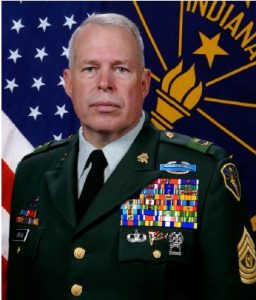
James M. Brown
James M. Brown distinguished himself both on active duty with the U.S. Army and, upon retirement, in his civilian life. Born in Los Angeles, California, he served in Vietnam as a member of the 101st Airborne Division. Upon his return to the United States he moved his family from Los Angles to Indianapolis where, after a short time, he joined the Indiana National Guard. While with the Indiana National Guard Mr. Brown served in various positions at Battalion, Brigade, Division and State levels; along the way he was promoted to Command Sergeant Major. Mr. Brown has continued to serve the veteran community of Indiana and is currently the Director of the Indiana Department of Veteran Affairs. During his 1970 tour of duty in Vietnam, then Sergeant Brown was twice wounded in combat, awarded two Purple Heart Medals and the Bronze Star with “Valor” device after his company was overrun by enemy soldiers in the A Shau Valley. Sergeant Brown was one of the few members of his company who survived eight days of fighting in the battle.
James M. Brown distinguished himself both on active duty with the U.S. Army and, upon retirement, in his civilian life. Born in Los Angeles, California, he served in Vietnam as a member of the 101st Airborne Division. Upon his return to the United States he moved his family from Los Angles to Indianapolis where, after a short time, he joined the Indiana National Guard. While with the Indiana National Guard Mr. Brown served in various positions at Battalion, Brigade, Division and State levels; along the way he was promoted to Command Sergeant Major. Mr. Brown has continued to serve the veteran community of Indiana and is currently the Director of the Indiana Department of Veteran Affairs. During his 1970 tour of duty in Vietnam, then Sergeant Brown was twice wounded in combat, awarded two Purple Heart Medals and the Bronze Star with “Valor” device after his company was overrun by enemy soldiers in the A Shau Valley. Sergeant Brown was one of the few members of his company who survived eight days of fighting in the battle.
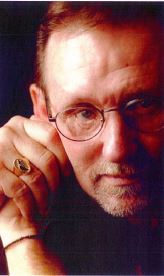
James Chancellor
James Chancellor spent a little more than a year and a half on active duty; however, his contributions to his state, nation, community, and fellow veterans have lasted well beyond that short time frame.Mr. Chancellor was an aviation mechanic and helicopter door gunner in Vietnam. During combat action in Vietnam he was wounded, awarded the Purple Heart, the Air Medal and numerous campaign and service medals. After returning to the United States, Mr. Chancellor spent his time assisting other returning veterans as they transitioned back to civilian life.He has been active in various veterans groups including the Disabled American Veterans, American Legion, and Veterans of Foreign Wars. Mr. Chancellor organized and participated in a 50 mile walk to raise money for the POW/MIA families in Indiana. He is proud of the ring he designed for returning Vietnam Veterans, which is worn in silent recognition of the service each of those returning from Vietnam has given to our nation.Mr. Chancellor has given numerous talks to veterans groups, at hospitals and colleges, coming to the aid of those who have suffered from Post-Traumatic Stress Disorder (PTSD).
James Chancellor spent a little more than a year and a half on active duty; however, his contributions to his state, nation, community, and fellow veterans have lasted well beyond that short time frame.Mr. Chancellor was an aviation mechanic and helicopter door gunner in Vietnam. During combat action in Vietnam he was wounded, awarded the Purple Heart, the Air Medal and numerous campaign and service medals. After returning to the United States, Mr. Chancellor spent his time assisting other returning veterans as they transitioned back to civilian life.He has been active in various veterans groups including the Disabled American Veterans, American Legion, and Veterans of Foreign Wars. Mr. Chancellor organized and participated in a 50 mile walk to raise money for the POW/MIA families in Indiana. He is proud of the ring he designed for returning Vietnam Veterans, which is worn in silent recognition of the service each of those returning from Vietnam has given to our nation.Mr. Chancellor has given numerous talks to veterans groups, at hospitals and colleges, coming to the aid of those who have suffered from Post-Traumatic Stress Disorder (PTSD).
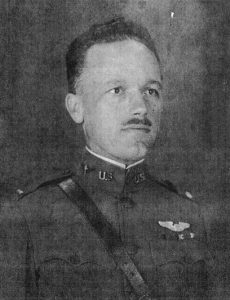
H. Weir Cook
H. Weir Cook distinguished himself both on active duty with the U.S. Army Air Corps and, upon retirement, in his civilian life. He was born in Wilkinson, Indiana, on June 30, 1892. In 1916 he joined the French Ambulance Corps and a year later returned to the United States to become a fighter pilot in the Army Air Corps as the U.S. entered WWI.Flying under the command of then Captain Eddie Rickenbacker, Colonel Cook honed his skills as a fighter pilot even at one point maneuvering in a “dog fight” with Herman Goering until they both gave up and Goering waved and retreated. Throughout the course of WWI, Colonel Cook distinguished himself by his bravery and extraordinary heroism. Twice he was awarded the Distinguished Service Cross – our nation’s second highest award for valor. Excerpts from one of the two citations reads: “for acts of extraordinary heroism, near Crepon, France, 30 October 1918, Lieutenant Cook is awarded the Distinguished Service Cross”. Lieutenant Cook attacked three enemy planes; after a few minutes of serious fighting, his guns jammed, but after clearing the jam, he returned to the attack, shot down one of the adversaries in flames and forced the others to retire to their own lines.” He was also the recipient of the Silver Star.After the war Colonel Cook continued to influence the development of the use of the airplane. He was instrumental in many things related to the use of airplanes; everything from the development of the parachute to the use of concrete for runways. He assisted in picking the site for the Indianapolis Airport, which was later named in his honor. Weir Cook’s contributions to the community, state and nation are extraordinary and numerous. In recognition of his contributions, the main terminal of the Indianapolis International Airport is named in his honor and a bronze statue of Colonel Cook is there, along with some of Colonel Cook’s personal items.
H. Weir Cook distinguished himself both on active duty with the U.S. Army Air Corps and, upon retirement, in his civilian life. He was born in Wilkinson, Indiana, on June 30, 1892. In 1916 he joined the French Ambulance Corps and a year later returned to the United States to become a fighter pilot in the Army Air Corps as the U.S. entered WWI.Flying under the command of then Captain Eddie Rickenbacker, Colonel Cook honed his skills as a fighter pilot even at one point maneuvering in a “dog fight” with Herman Goering until they both gave up and Goering waved and retreated. Throughout the course of WWI, Colonel Cook distinguished himself by his bravery and extraordinary heroism. Twice he was awarded the Distinguished Service Cross – our nation’s second highest award for valor. Excerpts from one of the two citations reads: “for acts of extraordinary heroism, near Crepon, France, 30 October 1918, Lieutenant Cook is awarded the Distinguished Service Cross”. Lieutenant Cook attacked three enemy planes; after a few minutes of serious fighting, his guns jammed, but after clearing the jam, he returned to the attack, shot down one of the adversaries in flames and forced the others to retire to their own lines.” He was also the recipient of the Silver Star.After the war Colonel Cook continued to influence the development of the use of the airplane. He was instrumental in many things related to the use of airplanes; everything from the development of the parachute to the use of concrete for runways. He assisted in picking the site for the Indianapolis Airport, which was later named in his honor. Weir Cook’s contributions to the community, state and nation are extraordinary and numerous. In recognition of his contributions, the main terminal of the Indianapolis International Airport is named in his honor and a bronze statue of Colonel Cook is there, along with some of Colonel Cook’s personal items.

George N. Craig
Lieutenant Colonel George Craig entered the U.S. Army Reserve in 1932 and was brought on active duty in March of 1942. During his period of active duty he served with General George Patton’s 3rd Army and became a close friend and lifetime confidant of President Dwight Eisenhower. One of his most prized possessions was a framed photo and memorabilia from the German surrender. Lieutenant Colonel Craig participated in the campaigns of Northern France, the Rhineland, Ardennes and Germany. For his military service he was twice awarded the Bronze Star Medal.During his lifetime he practiced law in Brazil, Indiana, and with a large international law firm in Washington, D.C. After some ten years with the D.C. international firm, he returned to Brazil and reopened his law practice. George Craig was nominated by his Party and easily won the election to become the 39th Governor of Indiana. His tenure as Governor saw implementation of many changes in Indiana. Among the changes introduced by Governor Graig include: a new Department of Corrections, establishment of a Uniform Traffic Code, reorganization of the State Police, the Department of Motor Vehicles, and the State Department of Health. Additionally, Governor Craig’s leadership saw the construction of the Indiana Toll Road. Although offered a Cabinet seat by President Eisenhower, he elected to finish his term as governor and stayed with the people of Indiana.In support of his community, state and nation, Governor Graig held membership in the Veterans of Foreign Wars, Elks, Indianapolis Service Club, the Scottish-Rite and American Legion. In 1949 he was elected National Commander of the American Legion and in 1950 he was honored as the “Outstanding Hoosier of the Year.”
Lieutenant Colonel George Craig entered the U.S. Army Reserve in 1932 and was brought on active duty in March of 1942. During his period of active duty he served with General George Patton’s 3rd Army and became a close friend and lifetime confidant of President Dwight Eisenhower. One of his most prized possessions was a framed photo and memorabilia from the German surrender. Lieutenant Colonel Craig participated in the campaigns of Northern France, the Rhineland, Ardennes and Germany. For his military service he was twice awarded the Bronze Star Medal.During his lifetime he practiced law in Brazil, Indiana, and with a large international law firm in Washington, D.C. After some ten years with the D.C. international firm, he returned to Brazil and reopened his law practice. George Craig was nominated by his Party and easily won the election to become the 39th Governor of Indiana. His tenure as Governor saw implementation of many changes in Indiana. Among the changes introduced by Governor Graig include: a new Department of Corrections, establishment of a Uniform Traffic Code, reorganization of the State Police, the Department of Motor Vehicles, and the State Department of Health. Additionally, Governor Craig’s leadership saw the construction of the Indiana Toll Road. Although offered a Cabinet seat by President Eisenhower, he elected to finish his term as governor and stayed with the people of Indiana.In support of his community, state and nation, Governor Graig held membership in the Veterans of Foreign Wars, Elks, Indianapolis Service Club, the Scottish-Rite and American Legion. In 1949 he was elected National Commander of the American Legion and in 1950 he was honored as the “Outstanding Hoosier of the Year.”
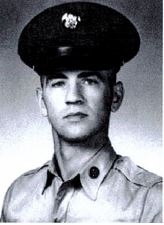
Robert J. Dorshak
Specialist Four Class Robert J. Dorshak distinguished himself by his heroic actions on August 25, 1968 while serving as a squad leader with Company C, 3rd Battalion, 22nd Infantry, 25th Infantry Division in the Republic of Vietnam. With complete disregard for his own safety, Robert exposed himself to a heavy volume of hostile fire as he moved from position to position checking on his men and directing their fire. Robert saved two American lives by eliminating a hostile soldier who had advanced to within a few feet of their position. While resupplying his men with ammunition, so they could continue the fight, he came under a murderous barrage of fire, and while moving to find cover, was mortally wounded.His valorous actions contributed immeasurably to the success of the mission and the defeat of the enemy force. Robert Dorshak’s personal bravery, aggressiveness, and devotion to duty were in keeping with the highest traditions of the military service and reflect great credit upon his unit, the United States Army, and himself. Robert Dorshak was posthumously awarded the Silver Star and the Purple Heart.
Specialist Four Class Robert J. Dorshak distinguished himself by his heroic actions on August 25, 1968 while serving as a squad leader with Company C, 3rd Battalion, 22nd Infantry, 25th Infantry Division in the Republic of Vietnam. With complete disregard for his own safety, Robert exposed himself to a heavy volume of hostile fire as he moved from position to position checking on his men and directing their fire. Robert saved two American lives by eliminating a hostile soldier who had advanced to within a few feet of their position. While resupplying his men with ammunition, so they could continue the fight, he came under a murderous barrage of fire, and while moving to find cover, was mortally wounded.His valorous actions contributed immeasurably to the success of the mission and the defeat of the enemy force. Robert Dorshak’s personal bravery, aggressiveness, and devotion to duty were in keeping with the highest traditions of the military service and reflect great credit upon his unit, the United States Army, and himself. Robert Dorshak was posthumously awarded the Silver Star and the Purple Heart.
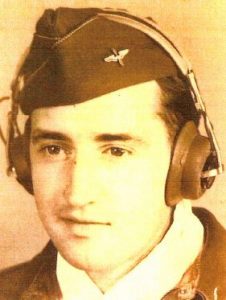
H. Troy Hanna
2nd Lieutenant H. Troy Hanna distinguished himself by his heroic actions while serving as the pilot of a P-38 fighter aircraft in the European Theater of WWII. On 8 October 1944, Lt. Hanna’s squadron of seven P-38s was escorting a convoy of four destroyers in the Aegean Sea. More than twenty-five enemy JU-87 Stuka fighter aircraft were sighted as those aircraft prepared to attack the convoy. 2LT Hanna directed a flight of three other P-38s to provide cover and disrupt the enemy attack. In the air battle that ensued, Lieutenant Hanna personally destroyed five of the attacking enemy aircraft, making him a World War II “Ace”, and damaging a sixth one.As the battle continued, Lieutenant Hanna twice saved his comrades by disrupting enemy attacks from the rear. His alertness, courage and flying skills were significant in this squadron’s achievement in destroying seventeen enemy aircraft without the loss of a single U.S. aircraft. His outstanding courage and ability as a combat pilot reflect the highest credit upon himself and the Armed Forces of the Unites States. For his actions that day, 2LT H. Troy Hanna was awarded the Distinguished Flying Cross. Before his tour of duty ended in that theater of war he also received twenty-five Air Medals.
2nd Lieutenant H. Troy Hanna distinguished himself by his heroic actions while serving as the pilot of a P-38 fighter aircraft in the European Theater of WWII. On 8 October 1944, Lt. Hanna’s squadron of seven P-38s was escorting a convoy of four destroyers in the Aegean Sea. More than twenty-five enemy JU-87 Stuka fighter aircraft were sighted as those aircraft prepared to attack the convoy. 2LT Hanna directed a flight of three other P-38s to provide cover and disrupt the enemy attack. In the air battle that ensued, Lieutenant Hanna personally destroyed five of the attacking enemy aircraft, making him a World War II “Ace”, and damaging a sixth one.As the battle continued, Lieutenant Hanna twice saved his comrades by disrupting enemy attacks from the rear. His alertness, courage and flying skills were significant in this squadron’s achievement in destroying seventeen enemy aircraft without the loss of a single U.S. aircraft. His outstanding courage and ability as a combat pilot reflect the highest credit upon himself and the Armed Forces of the Unites States. For his actions that day, 2LT H. Troy Hanna was awarded the Distinguished Flying Cross. Before his tour of duty ended in that theater of war he also received twenty-five Air Medals.
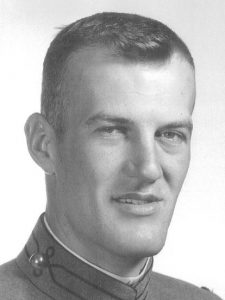
William A. Hoos, Jr.
William A. Hoos, Jr. was posthumously awarded the Silver Star for gallantry in action, on 14 February 1966, in the Republic of Vietnam; likewise, he was also awarded the Purple Heart Medal. Captain Hoos distinguished himself as Commanding Officer of “A” Company, 1st Battalion, 5th Mechanized Infantry, 25th Infantry Division, during a reconnaissance in force operation near Cu Chi, Republic of Vietnam. During the early morning hours Captain Hoos’ company made contact with and engaged a well-fortified Viet Cong force employing small arms and automatic weapons.With complete disregard for his own safety Captain Hoos continuously exposed himself to the intense hostile fire while leading his men through the heavily booby trapped area. He personally directed the fires of his men, administered to their needs, maintained an air of calmness and strong leadership, and assisted in protecting the landing site he had selected for the evacuation of casualties. He constantly cautioned his men about booby traps and personally pointed them out to his men that day.While directing fire against a hostile emplacement, a command detonated mine was exploded directly to the front of Captain Hoos which mortally wounded him. Inspired by his dauntless and heroic actions of that day, Captain Hoos’ men successfully completed the mission. Captain Hoos’ extraordinary heroism and devotion to duty in close combat against a numerically superior hostile force were in keeping with the highest traditions of the military service and reflect great credit upon himself, his unit, and the United States Army.
William A. Hoos, Jr. was posthumously awarded the Silver Star for gallantry in action, on 14 February 1966, in the Republic of Vietnam; likewise, he was also awarded the Purple Heart Medal. Captain Hoos distinguished himself as Commanding Officer of “A” Company, 1st Battalion, 5th Mechanized Infantry, 25th Infantry Division, during a reconnaissance in force operation near Cu Chi, Republic of Vietnam. During the early morning hours Captain Hoos’ company made contact with and engaged a well-fortified Viet Cong force employing small arms and automatic weapons.With complete disregard for his own safety Captain Hoos continuously exposed himself to the intense hostile fire while leading his men through the heavily booby trapped area. He personally directed the fires of his men, administered to their needs, maintained an air of calmness and strong leadership, and assisted in protecting the landing site he had selected for the evacuation of casualties. He constantly cautioned his men about booby traps and personally pointed them out to his men that day.While directing fire against a hostile emplacement, a command detonated mine was exploded directly to the front of Captain Hoos which mortally wounded him. Inspired by his dauntless and heroic actions of that day, Captain Hoos’ men successfully completed the mission. Captain Hoos’ extraordinary heroism and devotion to duty in close combat against a numerically superior hostile force were in keeping with the highest traditions of the military service and reflect great credit upon himself, his unit, and the United States Army.
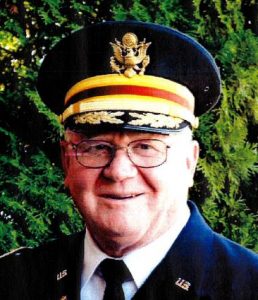
Daniel L. Oates
Daniel L. Oates has had distinguished careers in the Active and Reserve components of the U.S. Army and in his civilian life. As a member of the Army Transportation Corps, Colonel Oates served a little over five years on active duty before leaving for the U.S. Army Reserves and work in his own business. During his active duty time he completed training as an Army Ranger and as an Army Aviator. His decorations include the Legion of Merit, Bronze Star and 25 awards of the Air Medal, among other awards.His accomplishments and service while in the active and reserve forces of the United States are worthy of great praise. It is his service to the community, state, nation and veterans across Indiana that deserves special recognition. Colonel Oates has devoted much time and energy to assist veterans returning from combat theaters who suffer from Post-Traumatic Stress Disorder (PTSD) and Traumatic Brain Injury (TBI). He worked with others to establish Point Man of Newburgh, a non-denominational organization with a mission of helping veterans in need of assistance, especially those suffering from PTSD and TBI. He leads small group discussions for veterans needing assistance to overcome these conditions. He has helped organize fund drives for The Freedom Isn’t Free (an organization designed to support, among others, Vietnam veterans) and Point Man, each of which provide funding to support veterans and veteran organizations.In 2014, Colonel Oates organized and raised funds to transport Vietnam veterans and their wives to Washington D.C. to visit the Vietnam War Memorial. Colonel Oates’ selfless service and continuing support of veterans of all services reflects great credit upon himself and the organizations with which he is associated.
Daniel L. Oates has had distinguished careers in the Active and Reserve components of the U.S. Army and in his civilian life. As a member of the Army Transportation Corps, Colonel Oates served a little over five years on active duty before leaving for the U.S. Army Reserves and work in his own business. During his active duty time he completed training as an Army Ranger and as an Army Aviator. His decorations include the Legion of Merit, Bronze Star and 25 awards of the Air Medal, among other awards.His accomplishments and service while in the active and reserve forces of the United States are worthy of great praise. It is his service to the community, state, nation and veterans across Indiana that deserves special recognition. Colonel Oates has devoted much time and energy to assist veterans returning from combat theaters who suffer from Post-Traumatic Stress Disorder (PTSD) and Traumatic Brain Injury (TBI). He worked with others to establish Point Man of Newburgh, a non-denominational organization with a mission of helping veterans in need of assistance, especially those suffering from PTSD and TBI. He leads small group discussions for veterans needing assistance to overcome these conditions. He has helped organize fund drives for The Freedom Isn’t Free (an organization designed to support, among others, Vietnam veterans) and Point Man, each of which provide funding to support veterans and veteran organizations.In 2014, Colonel Oates organized and raised funds to transport Vietnam veterans and their wives to Washington D.C. to visit the Vietnam War Memorial. Colonel Oates’ selfless service and continuing support of veterans of all services reflects great credit upon himself and the organizations with which he is associated.

Edward Placencia
Edward Placencia enlisted in the U.S. Army and served three years on active duty in the service of his country. During those three years Edward Placencia achieved the rank of Sergeant and saw combat as an Infantryman in Vietnam. During his tour of duty in the Republic of Vietnam, Sergeant Placencia was awarded the Silver Star, the Bronze Star with Valor device, and the Purple Heart.On 19 November 1967, Sergeant Placencia distinguished himself by exceptional gallantry in action while engaged in military operations involving conflict with an armed hostile force in the Republic of Vietnam, while serving with Company A, 2nd Battalion (Airborne), 503rd Infantry during the battle of Dak To. Sergeant Placencia led his squad forward to the area of heaviest contact in a vicious assault against a numerically superior North Vietnamese force in order to link up with friendly forces that had been cut off by the enemy. He continually moved among his men directing their advance and installing confidence in them.Throughout the entire operation, Sergeant Placencia exposed himself to enemy automatic weapons fire and grenade and mortar fire, in order to lead his men and complete the mission. Upon completion of the link up, Sergeant Placencia learned that wounded men had been left in the area of initial enemy contact. He then placed a team leader in charge of his squad and with total disregard for his own safety dashed through the enemy’s intense barrage of fire to rescue his wounded men. Sergeant Placencia was wounded on his first rescue attempt but refused medical attention until he had brought all of the wounded men up the hill to a safer area. Sergeant Placenica’s display of courage, devotion of duty and leadership were in keeping with the highest traditions of the military service and reflect great credit upon himself, his unit and the United States Army.
Edward Placencia enlisted in the U.S. Army and served three years on active duty in the service of his country. During those three years Edward Placencia achieved the rank of Sergeant and saw combat as an Infantryman in Vietnam. During his tour of duty in the Republic of Vietnam, Sergeant Placencia was awarded the Silver Star, the Bronze Star with Valor device, and the Purple Heart.On 19 November 1967, Sergeant Placencia distinguished himself by exceptional gallantry in action while engaged in military operations involving conflict with an armed hostile force in the Republic of Vietnam, while serving with Company A, 2nd Battalion (Airborne), 503rd Infantry during the battle of Dak To. Sergeant Placencia led his squad forward to the area of heaviest contact in a vicious assault against a numerically superior North Vietnamese force in order to link up with friendly forces that had been cut off by the enemy. He continually moved among his men directing their advance and installing confidence in them.Throughout the entire operation, Sergeant Placencia exposed himself to enemy automatic weapons fire and grenade and mortar fire, in order to lead his men and complete the mission. Upon completion of the link up, Sergeant Placencia learned that wounded men had been left in the area of initial enemy contact. He then placed a team leader in charge of his squad and with total disregard for his own safety dashed through the enemy’s intense barrage of fire to rescue his wounded men. Sergeant Placencia was wounded on his first rescue attempt but refused medical attention until he had brought all of the wounded men up the hill to a safer area. Sergeant Placenica’s display of courage, devotion of duty and leadership were in keeping with the highest traditions of the military service and reflect great credit upon himself, his unit and the United States Army.
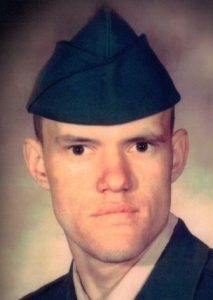
Michael E. Randall, Sr.
Michael E. Randall, Sr. of Noblesville, Indiana, enlisted in the Army on 19 February 1968. Corporal Randall died in combat on 10 October 1968. Corporal Randall was posthumously awarded the Distinguished Service Cross, the Bronze Star with “Valor” device, two additional awards of the Bronze Star, and the Purple Heart in addition to numerous service and campaign medals.Excerpts from the citation for the Distinguished Service Cross read as follows: For extraordinary heroism in connection with military operations involving conflict with a hostile force, Private First Class Randall distinguished himself by exceptionally valorous actions on 10 October 1968 while serving as a machine gunner with Company A, 2nd Battalion, 12th Infantry, 25th Infantry Division, near Cu Chi, Republic of Vietnam. Private Randall’s platoon was pinned down and his squad leader and point man lay wounded in an open field. With complete disregard for his safety, he advanced through the enemy’s cross fire to the front of the platoon and kept a steady fire on the enemy positions, allowing his comrades to evacuate the wounded men.Continuing his one man assault, he concentrated his fire directly into the hostile bunker’s gun port until another concealed enemy position opened fire, wounding him and damaging his machine gun. Private Randall returned to his platoon, secured a rifle and advanced on the second Viet Cong fortification and killed both occupants. Although severely wounded, Private Randall ran across an open area toward an enemy machine gun position that had his platoon pinned down. As he was tossing hand grenades into the enemy bunker, Private Randall was mortally wounded. Private Randall’s extraordinary heroism and devotion to duty, at the cost of his life, were in keeping with the highest traditions of the military service and reflect great credit upon himself, his unit and the United States Army.
Michael E. Randall, Sr. of Noblesville, Indiana, enlisted in the Army on 19 February 1968. Corporal Randall died in combat on 10 October 1968. Corporal Randall was posthumously awarded the Distinguished Service Cross, the Bronze Star with “Valor” device, two additional awards of the Bronze Star, and the Purple Heart in addition to numerous service and campaign medals.Excerpts from the citation for the Distinguished Service Cross read as follows: For extraordinary heroism in connection with military operations involving conflict with a hostile force, Private First Class Randall distinguished himself by exceptionally valorous actions on 10 October 1968 while serving as a machine gunner with Company A, 2nd Battalion, 12th Infantry, 25th Infantry Division, near Cu Chi, Republic of Vietnam. Private Randall’s platoon was pinned down and his squad leader and point man lay wounded in an open field. With complete disregard for his safety, he advanced through the enemy’s cross fire to the front of the platoon and kept a steady fire on the enemy positions, allowing his comrades to evacuate the wounded men.Continuing his one man assault, he concentrated his fire directly into the hostile bunker’s gun port until another concealed enemy position opened fire, wounding him and damaging his machine gun. Private Randall returned to his platoon, secured a rifle and advanced on the second Viet Cong fortification and killed both occupants. Although severely wounded, Private Randall ran across an open area toward an enemy machine gun position that had his platoon pinned down. As he was tossing hand grenades into the enemy bunker, Private Randall was mortally wounded. Private Randall’s extraordinary heroism and devotion to duty, at the cost of his life, were in keeping with the highest traditions of the military service and reflect great credit upon himself, his unit and the United States Army.

Thomas J. Scecina
Thomas J. Scecina was born in Vicksburg, Greene County, Indiana, on 16 September 1910. He was ordained a priest for the Archdiocese of Indianapolis on 11 June 1935. Thomas Scecina enlisted in the Chaplains’ Reserve Corps on 5 October 1939 and was assigned to Fort McKinley on Luzon, Philippine Islands, and was on duty there when U.S. Forces surrendered to the Japanese Army. He survived the Bataan Death March and, following two years of imprisonment, he freely elected to accompany U.S. prisoners being shipped to Japan.The Japanese ship, the Arisan Maru, was not marked as a POW transport and was mistakenly sunk by a U.S. submarine torpedo. All but 12 of the 1,800 U.S. prisoners on board the ship were lost at sea. Chaplain/Father Scecina and one other Chaplain on board the ill-fated ship each took opposite ends of the ship and administered to the spiritual needs of the U.S. servicemen in preparation for their certain death. Father Scecina gave general absolution to all of the men and then heard confessions over a three-hour period until the ship finally broke up and sank. At the age of 34, Father Thomas Scecina went to his death with his men on 24 October 1944.For his courageous efforts in support of his men and his Catholic faith and to recognize his remarkable courage in the face of certain death, Captain Thomas Scecina was posthumously awarded the Silver Star, Bronze Star and the Purple Heart, along with numerous campaign and service medals. Scecina Memorial High School in Indianapolis, Indiana, proudly bears his name. Here are the words of a commendation acknowledging Father Tom Scecina’s patriotic and courageous service and sacrifice: “In Grateful Memory of Captain Thomas J. Scecina who died in the service of his country in the Southwest Pacific Area, 24 October 1944. He stands in the unbroken line of patriots who have dared to die that freedom might live, and grow, and increase its blessings. Freedom lives, and through it, he lives – in a way that humbles the undertakings of most men” … Signed, Franklin D. Roosevelt, President of the United States of America.
Thomas J. Scecina was born in Vicksburg, Greene County, Indiana, on 16 September 1910. He was ordained a priest for the Archdiocese of Indianapolis on 11 June 1935. Thomas Scecina enlisted in the Chaplains’ Reserve Corps on 5 October 1939 and was assigned to Fort McKinley on Luzon, Philippine Islands, and was on duty there when U.S. Forces surrendered to the Japanese Army. He survived the Bataan Death March and, following two years of imprisonment, he freely elected to accompany U.S. prisoners being shipped to Japan.The Japanese ship, the Arisan Maru, was not marked as a POW transport and was mistakenly sunk by a U.S. submarine torpedo. All but 12 of the 1,800 U.S. prisoners on board the ship were lost at sea. Chaplain/Father Scecina and one other Chaplain on board the ill-fated ship each took opposite ends of the ship and administered to the spiritual needs of the U.S. servicemen in preparation for their certain death. Father Scecina gave general absolution to all of the men and then heard confessions over a three-hour period until the ship finally broke up and sank. At the age of 34, Father Thomas Scecina went to his death with his men on 24 October 1944.For his courageous efforts in support of his men and his Catholic faith and to recognize his remarkable courage in the face of certain death, Captain Thomas Scecina was posthumously awarded the Silver Star, Bronze Star and the Purple Heart, along with numerous campaign and service medals. Scecina Memorial High School in Indianapolis, Indiana, proudly bears his name. Here are the words of a commendation acknowledging Father Tom Scecina’s patriotic and courageous service and sacrifice: “In Grateful Memory of Captain Thomas J. Scecina who died in the service of his country in the Southwest Pacific Area, 24 October 1944. He stands in the unbroken line of patriots who have dared to die that freedom might live, and grow, and increase its blessings. Freedom lives, and through it, he lives – in a way that humbles the undertakings of most men” … Signed, Franklin D. Roosevelt, President of the United States of America.

Charles R. Williams
Charles R. Williams was a veteran of the United States Navy, serving for three years, including time in the waters off of the Republic of Vietnam. Reverend Williams was honorably separated from the Navy in 1968. After his Naval service, he became very active in support of community activities across the state of Indiana and the nation. His educational achievements include studies at Black Hawk College, Moline, Illinois; Indiana State University, Terre Haute, Indiana, and Martin Center College, Indianapolis, Indiana, IN. In 1997 Reverend Williams received an Honorary Doctorate of Humane Letters from Martin University. His contributions to the community are vast and the list is nearly endless.In the 1970s Reverend Williams served in the Office of the Mayor of Indianapolis to ensure minorities were given the opportunity for appointment to boards and agencies to which the Mayor had appointment authority. During this same time frame he became the volunteer President of the Indianapolis Black Expo and led that venture from a part-time volunteer operation, concerned with only a week-long event in the city, to a full year operation and raised it from a substantial deficit position to a profitable venture. Likewise, Reverend Williams was one of the founders of the “Circle City Classic,” an annual collegiate football game that raises scholarship money for those in need.While suffering from prostate cancer, Reverend Williams continued his efforts to improve life for minorities in the state of Indiana. Even as he struggled with his own prostate cancer problems, he served as spokesman for several prostate cancer awareness campaigns and made many public service announcements. As Chairman of PUSH for Excellence Month he was instrumental in having over 5,000 high school students pledge to push for excellence in their school work. He was, also, instrumental in making Dr. Martin Luther King, Jr.’s birthday a legal holiday in the City of Indianapolis. His efforts supporting various organizations whose charter is to benefit the communities, from which they come, will ensure his efforts will continue to pay dividends for many years.
Charles R. Williams was a veteran of the United States Navy, serving for three years, including time in the waters off of the Republic of Vietnam. Reverend Williams was honorably separated from the Navy in 1968. After his Naval service, he became very active in support of community activities across the state of Indiana and the nation. His educational achievements include studies at Black Hawk College, Moline, Illinois; Indiana State University, Terre Haute, Indiana, and Martin Center College, Indianapolis, Indiana, IN. In 1997 Reverend Williams received an Honorary Doctorate of Humane Letters from Martin University. His contributions to the community are vast and the list is nearly endless.In the 1970s Reverend Williams served in the Office of the Mayor of Indianapolis to ensure minorities were given the opportunity for appointment to boards and agencies to which the Mayor had appointment authority. During this same time frame he became the volunteer President of the Indianapolis Black Expo and led that venture from a part-time volunteer operation, concerned with only a week-long event in the city, to a full year operation and raised it from a substantial deficit position to a profitable venture. Likewise, Reverend Williams was one of the founders of the “Circle City Classic,” an annual collegiate football game that raises scholarship money for those in need.While suffering from prostate cancer, Reverend Williams continued his efforts to improve life for minorities in the state of Indiana. Even as he struggled with his own prostate cancer problems, he served as spokesman for several prostate cancer awareness campaigns and made many public service announcements. As Chairman of PUSH for Excellence Month he was instrumental in having over 5,000 high school students pledge to push for excellence in their school work. He was, also, instrumental in making Dr. Martin Luther King, Jr.’s birthday a legal holiday in the City of Indianapolis. His efforts supporting various organizations whose charter is to benefit the communities, from which they come, will ensure his efforts will continue to pay dividends for many years.